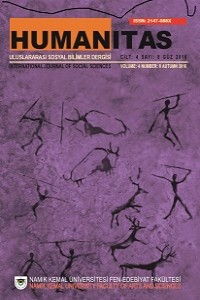GUY DE MAUPASSANT’IN DAĞ OTELİ ÖYKÜSÜNDEKİ UZAMA GÖSTERGEBİLİMSEL BİR YAKLAŞIM (A SEMIOTIC APPROACH TO SPACE IN THE STORY MOUNTAIN HOTEL BY GUY DE MAUPASSANT)
Öz
Öz: Öykü, geçmişten günümüze, yazınsal bir tür olarak okuyucuların ilgi odağı, dilbilimcilerin, göstergebilimcilerin araştırma nesnesi olmuştur. Birçok kuram ve araştırma yöntemine göre incelenen bu ürünlerin ortak noktası, “anlatı kişileri”, “uzam” ve “zaman” öğelerini içlerinde barındırmalarıdır. Bu çalışmada ünlü Fransız öykü yazarı Guy de Maupassant’ın 1886 yılında yazdığı Dağ Oteli öyküsünde uzamın yerini ve işlevini ortaya konmaya çalışılmaktadır. Uzam anlatılardaki anlam üretim sürecinde önemli bir role sahiptir. Anlatının diğer öğeleri olan “zaman” ve “anlatı kişileri” ile anlam ilişkisi içerisindedir. Anlatıda uzamı incelerken, bu öğenin öyküde kullanılan “zaman”la ve anlatı “kişi”leriyle olan ilişkileri, bu ilişkilerde nasıl bir konuma yerleştiği, onları nasıl değiştirdiği ve onlar tarafından nasıl değiştirildiği değerlendirilmektedir. Buradaki dayanak noktamız, anlam üretiminde karşıtlıkların incelenmesini temel alan göstergebilimsel yöntemdir. A. J. Greimas’ın öncülüğünü yaptığı göstergebilim kuramı, yazınsal ürünlerdeki anlam üretim sürecinin hem yüzeysel yapıda, hem de derin yapıda inceleyen bir yöntemdir. Bu yöntemin anlam üretimini karşıtlıklar üzerinden incelemesi, çalışmamızın ana noktasını oluşturan “uzam” öğesine ait değerleri detaylı bir şekilde ortaya koyacaktır. Bu değerleri sınıflandırmak, birbirleriyle olan anlam ilişkilerini çözümlemek ve öykünün bütünsel anlamına kattıklarını görmek açısından göstergebilim yöntemini kullanmanın gerekli olduğu düşüncesindeyiz. Bu öğenin, öyküdeki anlam katmanlarını oluşturmadaki rolü göz önünde bulundurulduğunda, çalışmamızın edebi metin türlerinde anlam oluşumu ve ilişkilerini inceleyen araştırmacılara da dayanak olacağı düşüncesindeyiz.
Abstract: The story, from past to present, as a literary genre, has been the focus of attention of the reader, and object of research, linguists, semioticians. The common point of the products, which are examined according to many theories and research methods, is that they contain “character”, “space” and “time” items. In this study, it is aimed to present the function and place of “space” in the story “Mountain Hotel” written by the famous French writer Guy Maupassant in 1886. Space has an important role in terms of the meaning production process in the story. It also has an interaction with the other elements; “time” and “character”, in meaning process. While examining the element of space in the story, the relationship of this element with time of the story and characters, its place in this relationship, and its transformation are evaluated. Our point of departure here is the semiotic method which is based on the examination of the production of contrast. A.J. Greimas led to the theory of semiotics, who examines the literary products in the meaning process, in the surface structure, and in the deep structure. Meaning production by using the opposite structures will lay out the values of the element of “space” in a detailed manner which is the main point of our study. We think that it is necessary to use semiotics method, to see these values, what they mean in terms of holistic means, to resolve their relationship with each other and to classify them. Our claim is that, this item, considering its role in creating layers of meaning in the story, would be a kind of basis of researchers who examine the formation of meaning and relationships in literary texts.
Anahtar Kelimeler
Göstergebilim Uzam Anlatı Fantastik Öykü. (Semiotics Space Story Fantastic Story.)
Kaynakça
- Bachelard, G. (2008). Uzamın Poetikası. (Çev. Alp Tümertekin). İstanbul: İthaki Yayınları.
- Bertrand, D. (2000). Précis de sémiotique littéraire. Paris : Nathan.
- Greimas, A. J. ve Courtès, J. (1979) Sémiotique, dictionnaire raisonné de la théorie du langage. Paris: Hachette.
- Kıran, A. ve Kıran, Z. (2007). Yazınsal Okuma Süreçleri. (3. Baskı). Ankara: Seçkin Yayınevi.
- Korkut, E. (1999). Verlaine’de Uzam-Özne İlişkisi. Dilbilim Araştırmaları, 125-133. İstanbul: Simurg Yayınları.
- Taşçıoğlu, M. (2013). Bir Görsel İletişim Platformu Olarak Mekân. İstanbul: Yem Yayınları.
- Todorov, T. (2004). Fantastik, Edebi Türe Yapısal Bir Yaklaşım. (Çev. Nedret Öztokat). İstanbul: Metis Yayınları.
- Reuter, Y. (1196). Introduction à l’analyse du roman. Paris: Dunod.
- Yücel, T. (1979). Anlatı Yerlemleri. İstanbul: Ada Yayınları.
- Maupassant, G.. (2000). Jules Amcam (Seçme Öyküler). [Elektronik Sürüm]. (Çev. Enver Behgiç Koryak). İstanbul: Cumhuriyet Kitap. (1883).
Ayrıntılar
| Bölüm | Tüm Sayı |
|---|---|
| Yazarlar | |
| Yayımlanma Tarihi | 9 Kasım 2016 |
| Yayımlandığı Sayı | Yıl 2016 Cilt: 4 Sayı: 8 |









